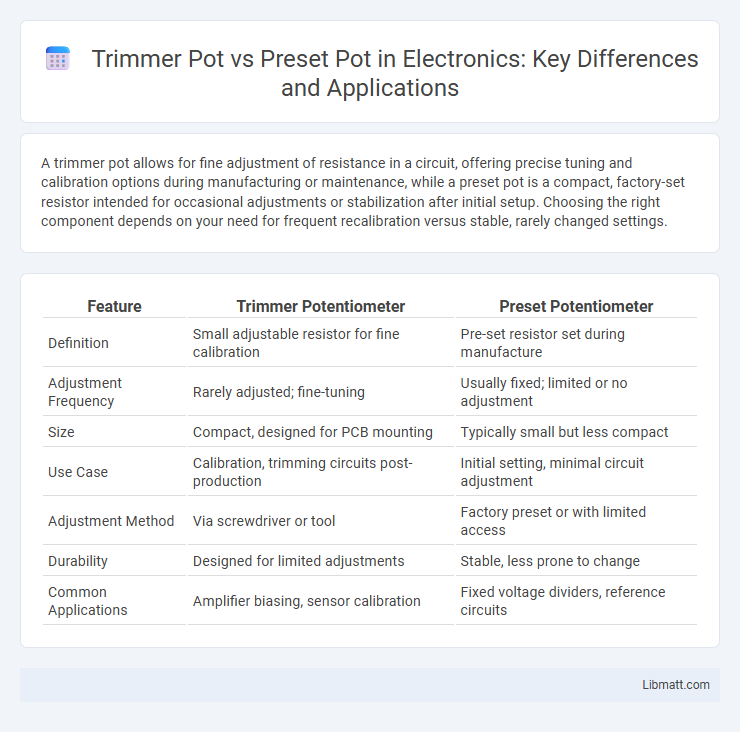A trimmer pot allows for fine adjustment of resistance in a circuit, offering precise tuning and calibration options during manufacturing or maintenance, while a preset pot is a compact, factory-set resistor intended for occasional adjustments or stabilization after initial setup. Choosing the right component depends on your need for frequent recalibration versus stable, rarely changed settings.
Table of Comparison
| Feature | Trimmer Potentiometer | Preset Potentiometer |
|---|---|---|
| Definition | Small adjustable resistor for fine calibration | Pre-set resistor set during manufacture |
| Adjustment Frequency | Rarely adjusted; fine-tuning | Usually fixed; limited or no adjustment |
| Size | Compact, designed for PCB mounting | Typically small but less compact |
| Use Case | Calibration, trimming circuits post-production | Initial setting, minimal circuit adjustment |
| Adjustment Method | Via screwdriver or tool | Factory preset or with limited access |
| Durability | Designed for limited adjustments | Stable, less prone to change |
| Common Applications | Amplifier biasing, sensor calibration | Fixed voltage dividers, reference circuits |
Introduction to Trimmer Pot and Preset Pot
Trimmer pots and preset pots are types of variable resistors used for precise adjustments in electronic circuits. A trimmer pot is designed for fine-tuning resistance values during calibration or maintenance, offering adjustability after installation. In contrast, a preset pot is typically set once during manufacturing or setup to establish a fixed resistance value and is not intended for frequent adjustments.
Definitions and Key Differences
A trimmer pot, or trimmer potentiometer, is a small adjustable resistor designed for fine-tuning and calibration in electronic circuits, typically adjusted only during manufacturing or servicing. A preset pot serves a similar purpose but is often larger, allowing for easier manual adjustment to set parameters like voltage or current. Understanding the key differences helps you select the right component for precise control or user-friendly adjustments in your electronic projects.
Construction and Design Comparison
Trimmer pots feature a compact, adjustable rotor positioned on a multi-turn coil for precise resistance tuning, typically housed in a durable plastic casing designed for infrequent adjustments. Preset pots incorporate a fixed resistive element with a single-turn wiper mechanism sealed within a robust, often metal body, intended for stable, reliable resistance settings after factory calibration. The construction of trimmer pots emphasizes fine customization with multi-turn control, while preset pots prioritize durability and minimal user interaction through a simpler, fixed design.
Common Applications of Trimmer Pots
Trimmer pots are commonly used for fine-tuning and calibration in electronic circuits, particularly in applications like adjusting contrast in displays, setting bias currents in amplifiers, and calibrating sensor outputs. These small variable resistors enable precise resistance adjustment during manufacturing or servicing without frequent manual readjustment. Their compact design and reliability make them ideal for circuit boards requiring occasional tuning rather than continuous user control.
Typical Uses for Preset Pots
Preset pots are commonly used in electronic devices for calibration and fine-tuning, such as adjusting voltage levels in power supplies or setting bias currents in amplifiers. They are ideal for applications requiring infrequent adjustment due to their compact size and durability. Typical uses include tuning frequency in oscillators, setting offset voltages in operational amplifiers, and calibrating sensors during manufacturing.
Accuracy and Adjustment Ease
Trimmer pots offer high accuracy for fine-tuning circuit parameters, making them ideal for calibration tasks where precise adjustments are critical. Their design allows for small, incremental changes, but they often require specialized tools for adjustment, limiting ease of use. Preset pots, on the other hand, strike a balance between accuracy and ease of adjustment, enabling quicker manual tuning while still maintaining reasonable precision for most applications.
Durability and Reliability Factors
Trimmer pots typically offer higher durability in low-frequency adjustment scenarios due to their robust internal construction, which reduces wear from frequent changes. Preset pots are designed for infrequent or one-time settings, making them less reliable for repeated adjustments as their reliability may degrade with use. Choosing the right option impacts your device's long-term performance, with trimmer pots favored for stable, long-lasting calibration and preset pots suited for fixed, seldom-altered settings.
Cost and Availability Analysis
Trimmer potentiometers generally cost more than preset potentiometers due to their higher precision and durability, making them ideal for fine-tuning electronic circuits in professional applications. Preset potentiometers are widely available, often mass-produced and cheaper, suited for less critical adjustments and volume control functions. Market availability favors presets for general use, while trimmers are typically sourced from specialized electronic component suppliers.
How to Choose Between Trimmer Pot and Preset Pot
Choosing between a trimmer pot and a preset pot depends on the need for adjustability and precision in circuit tuning. Trimmer pots offer fine-tuning capabilities with adjustable resistance ideal for calibration during manufacturing or maintenance, while preset pots provide fixed resistance values set at the factory for consistent performance in applications requiring minimal adjustment. Selecting between them involves assessing the requirement for on-the-fly adjustment versus stable, pre-configured resistance in electronic circuits or devices.
Conclusion and Expert Recommendations
Trimmer pots offer precise calibration capabilities ideal for fine-tuning circuit performance during manufacturing, whereas preset pots provide a fixed adjustment setting that simplifies user control in final applications. Experts recommend using trimmer pots in low-profile, high-precision environments that demand reliability without frequent user intervention, while preset pots are favored for applications requiring robust, long-term stability and ease of adjustment. Selecting between the two depends on factors such as adjustability needs, space constraints, and the level of maintenance acceptable in the device lifecycle.
Trimmer Pot vs Preset Pot Infographic

 libmatt.com
libmatt.com